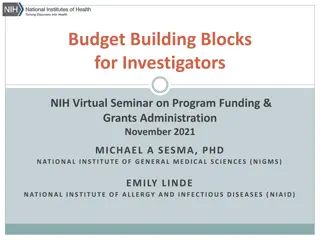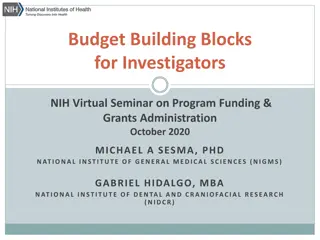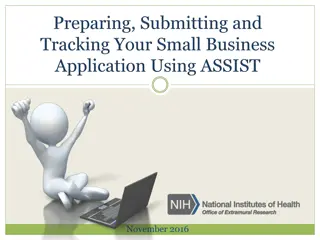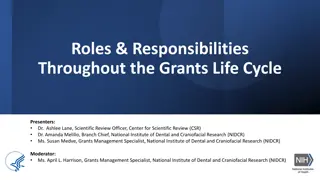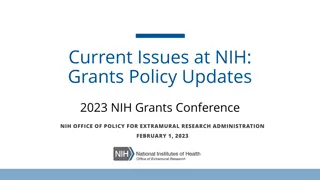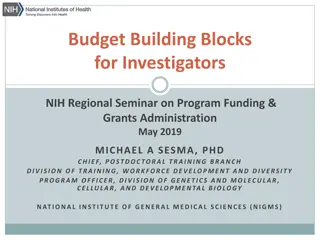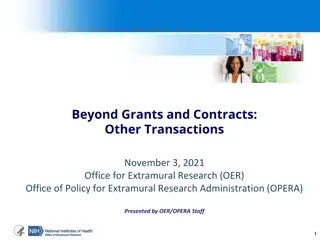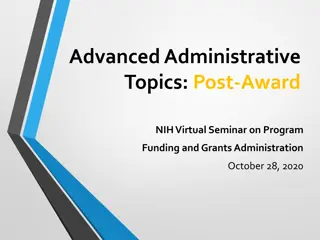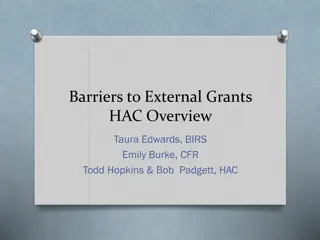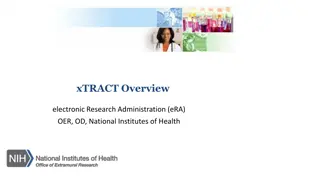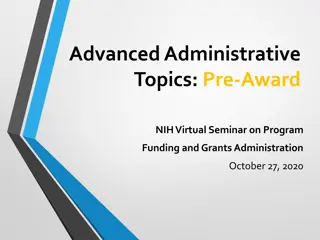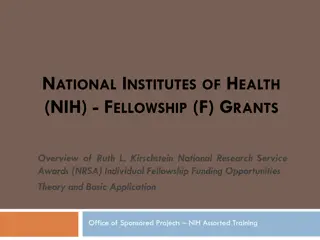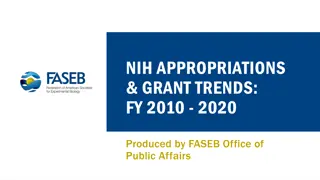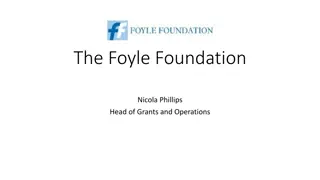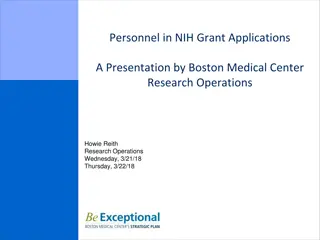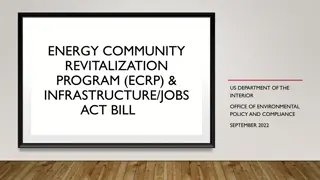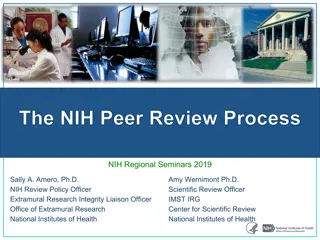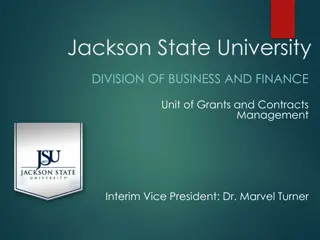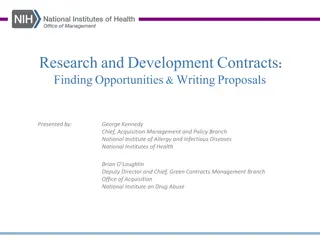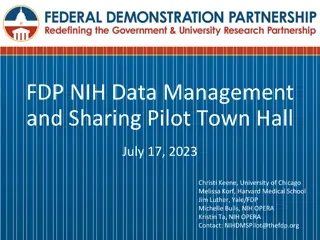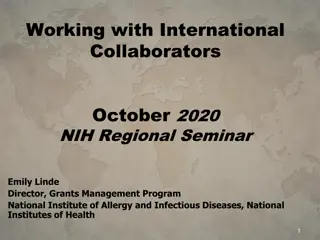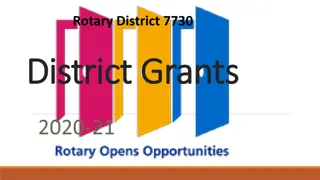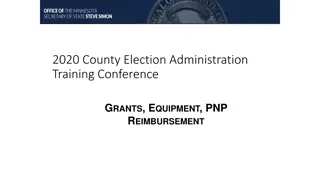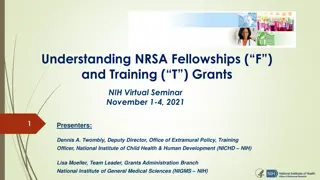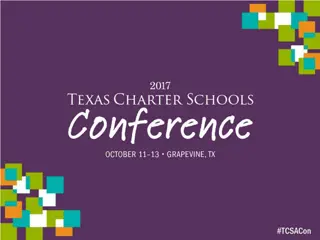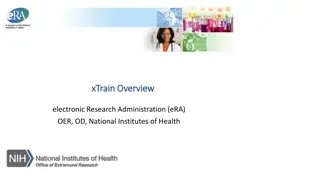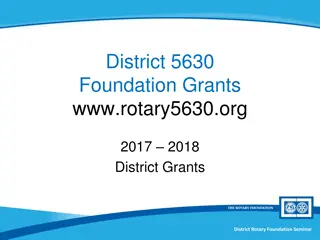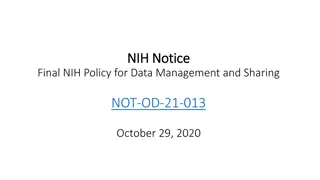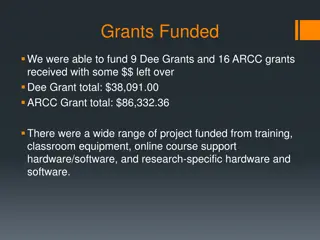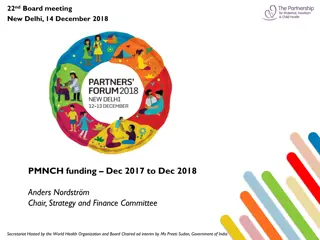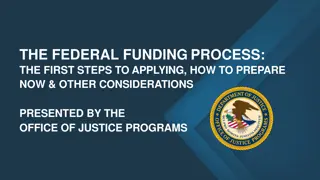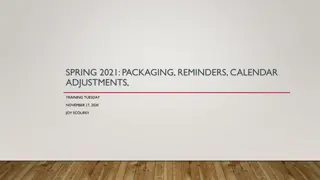NIH Funding and Grants Administration - Tips and Guidelines
Explore essential tips and guidelines for applying to the National Institutes of Health (NIH) for funding and grants. Learn about budget basics, preparing budgets, award policy issues, and key considerations for successful grant applications. Understand who the grant is awarded to and the responsible parties involved in the process.
Download Presentation

Please find below an Image/Link to download the presentation.
The content on the website is provided AS IS for your information and personal use only. It may not be sold, licensed, or shared on other websites without obtaining consent from the author. Download presentation by click this link. If you encounter any issues during the download, it is possible that the publisher has removed the file from their server.
E N D
Presentation Transcript
National Institutes of Health (NIH) - Turning Discovery Into Health Budget Building Blocks for Investigators NIH Regional Seminar on Program Funding & Grants Administration October 2016 M I C H A E L A S E S M A , P H D C H I E F , P O S T D O C T O R A L T R A I N I N G B R A N C H D I V I S I O N O F T R A I N I N G , W O R K F O R C E D E V E L O P M E N T A N D D I V E R S I T Y P R O G R A M O F F I C E R , D I V I S I O N O F G E N E T I C S A N D D E V E L O P M E N T A L B I O L O G Y N A T I O N A L I N S T I T U T E O F G E N E R A L M E D I C A L S C I E N C E S ( N I G M S )
Budget Basics Getting Started Types of Budgets Budget Components Preparing Budgets Other Considerations Award Policy Issues
Tips for Getting Started Applications submitted to the NIH must be in response to a Funding Opportunity Announcement (FOA) Carefully Read the FOA: Period of support (number of years) Dollar limit of support (for example $100K total cost (TC) or $100K direct cost (DC)) Type of budget submission (modular or categorical) Larger research grants (>$500K DC in any year) may need prior approval to submit. Contact Program Staff if you have any questions!
Tips for Getting Started Know your limits! o FOAs may have caps and/or exclusions o Some expenses are unallowable (e.g. lobbying, entertainment) Identify what is necessary and reasonable Request for lots of new equipment suggests an insufficient environment to do the work Research grants are NOT training programs, but federal assistance to achieve a scientific goal. Assign personnel wisely! Reviewers will comment on the budget NIH Grant Application Budget Basics: http://grants.nih.gov/grants/developing_budget.htm
To Whom is the Grant Awarded? The Institution Who is Responsible? The Institution The Principal Investigator The Departmental Administrator The Department Chair
Detailed and Modular Budgets Detailed [Categorical or Itemized] o Fellowship Applications [F]: tuition & fees o Career Development Awards [K]: salary, materials, supplies o Institutional Training Grants [T] o SBIR/STTR o Research Project Grants* o Multi-Project/Consortium* Modular o Research Project Grants (e.g. R01, R21)* No difference in allowable costs or post-award financial management requirements
Modular Budgets o Grant applications with annual direct costs $250,000 use Modular Budgets Applicable for R01, R03, R15, R21 and R34 applications o Budget is built on modules of $25,000: future year escalations are not allowed o No categorical budget [unless asked] at time of application at time of award PHS SF424 Research & Related Budget: 5.4 Modular Budget Component forms 9
Modular Budgets (cont.) List all personnel involved at Applicant Organization List all personnel associated with Consortia/Contractual arrangements NIH may request detailed budget to address specific issues Additional information on modular budgets: http://grants.nih.gov/grants/funding/modular/modular.htm
Direct vs. Indirect Costs Direct costs: directly attributable to the project and allowable salaries w/ fringe benefits, student fees/tuition, consultants, equipment, supplies, travel, publication, shared facility fees F&A (Indirect) costs: Facilities & Administrative costs, or overhead shared by all cost centers Specific rate is negotiated by the institution with the government Fee: reasonable profit factor available to for-profit organizations, consistent with normal profit margins Small business programs (SBIR/STTR) only Not to exceed 7% of total costs NIH Grant Application Budget Basics: http://grants.nih.gov/grants/developing_budget.htm
Sections A & B: Personnel EFFORT: Person-Months Amount of time (effort) on project by PI(s). Calendar vs. Academic/Summer months The number, qualifications and amount of time needed for other personnel Co-investigators Technicians Postdoctoral Fellows Undergraduate & Graduate Students https://grants.nih.gov/grants/policy/person_months_faqs.htm Calculating person months : https://grants.nih.gov/grants/policy/person_months_faqs.htm 15
Sections A & B: Personnel SALARY REQUESTS Percent SALARY Percent EFFORT Example: You devote 9 person-months [75%] effort You can request between 0% to 75% of your salary* * up to legislated salary cap
Personnel (continued) No magic numbers regarding the qualifications and/or number of individuals needed for each aim. Each individual listed in the budget should have a specific role on the project Be realistic about what each individual can accomplish and the time necessary for the work. Explain any fluctuations in effort levels and/or staffing levels in out years (in the budget justification).
Salary Cap Salary Limitation (NOT-OD-16-059) is one of the congressional mandates in the NIH Appropriation Restricts the amount of direct salary that can be paid with federal funds under a grant or contract to Executive Level II of the Federal Executive Pay Scale ($185,100) However, the participant s actual base salary (even if exceeding the cap) should be used on the budget page. Helps NIH know the current pay scales and justify increases Grants Specialists will adjust to meet the cap at the time of award http://grants.nih.gov/grants/guide/notice-files/NOT-OD-15-049.html
Section C: Equipment Additional expensive equipment (defined as > $5000) can be requested. Equipment should be project specific be sure to include a written justification. Most equipment is requested during the first year of the grant. If using a modular budget format, extra module(s) may be requested to cover equipment.
Section D: Travel Amount is usually small: $1,000 - 2,000 per scientific meeting per individual per year Generally supports travel for presenting the results of the grant 1-2 meetings per year 2-3 personnel Travel for data collection, to access resources or unique instrumentation or tools may be requested Justification should clearly state how travel is related to completing the aims and goals of the proposed research
Section E: Participant/Trainee Support Costs Unless stated in the FOA, this section should be left blank for NIH applications Tuition remission should be in Section F: Other Direct Costs
Section F: Other Direct Costs Estimate the materials and supplies needed for the personnel involved. Usually ~$12,000 15,000/year per FTE Animal intensive studies, studies involving human subjects, or extensive bioinformatics, nanofabrication/foundary expenses tend to be more costly. In silico or in vitro studies tend to be less costly for supplies. Publication costs Equipment maintenance Consortium/subcontracts Tuition remission Shared facility fees
Budget Justification Reviewers and Administrator use this to determine if the scope of work matches the request Explain the specific responsibilities for each team member Justify unusual/large expenses Show the value of subcontracts/consortia Provide a separate budget request and justification for any subcontract/consortium
Allowable vs. Unallowable Costs Allowable Unallowable Salaries (NIH salary cap: currently $185,100) Equipment (needed for the project) Supplies (includes equipment under $5K) Travel Consultants Consortiums Alterations & Renovations Other (equipment maintenance costs, animal costs, fee for service) Bad debt (200.426) Alcohol (200.423) Improper payments (200.428) Advertising (200.421), except for recruitment, procurement of goods, disposal of scraps/surplus materials, program outreach Public relations (200.421), except for costs required by the federal awardee Alumni/ae Activities (200.421)
R01 Modular Budget Start with an itemized budget (R&R budget component 4.7.1) Create out-year budgets Divide total budget for all years by number of years Request same number of modules each year* Consortia total costs are calculated separately and may be rounded to nearest $1,000 1. 2. 3. 4. 5. * exception for equipment
Add it all Up Year 1 Cal Mon Req. Salary Fringe Benefits Req. Funds A. Senior/Key Person PI co-investigator B. Other Personnel Postdoc Assoc Grad Student Grad Student C. Equipment Microscope D. Travel - (2 meetings) E. Participant/Trainee F. Other Direct Costs Materials/Supplies Publication Costs Subaward/Consortium/Contractual costs Tuition Remission G. Total Direct Costs 2 1 15,333 0 4,293 0 19,626 0 12 12 12 47,484* 23,376* 23,376* 13,723 6,077 6,077 61,207 29,454 29,454 19,000 4,000 usually left blank 196,774 25,533 1,500 none 7,000 * Based on new NRSA levels
Add it all up Calculate the direct costs for the first year. (in the example, Year 1 budget = $196,774) Calculate the direct costs for subsequent years taking into account salary and research cost increases and changes in funds requested for equipment. Year 2 = $177,774 Year 3 = $183,107 Year 4 = $188,600 Year 5 = $194,258
Determining the Need for a Modular Budget? Calculate the total direct costs for all years Total direct costs for 5 years = $940,513 Divide total by the number of years requested Average direct costs = $188,103/yr Investigator-initiated R01s up to $250,000/yr must use modular format* Except applications from foreign (non-U.S.) institutions
Converting Average Direct Costs to the Modular Format Round up to the next module (number divisible by $25,000) In the example, $188,103/yr rounds up to $200,000/yr No yearly increases for inflation First year may include additional modules for one- time expenses like equipment In the example, PI could add one additional module to year 1 = $225,000
R01 Budget with Consortium Costs Prepare an itemized budget for the parent award Prepare an itemized budget for consortium/subcontract costs, including: Personnel o salary and benefits Travel o professional or investigator meeting Other Direct Costs o Materials and Supplies Total Direct Costs = $45,000 $33,000 $ 2,000 $10,000
Total Consortium Costs Consortium Direct Costs = Consortium F&A consortium institution (at 50%) = $45,000 $22,500 Consortium Total Costs = *Remember you may round to the nearest $1,000 $67,500
Add it all up Base Salary Cal Req Salary Fringe Ben Req Funds Month A. Senior Personnel PI Co-I 92,000 85,000 2 1 15,333 4,293 19,626 - - - B. Other Personnel Postdoc Graduate Student Graduate Student Microscope 2 meetings 12 12 12 47,484 23,376 23,376 13,723 6,078 6,078 61,207 29,454 29,454 19,000 4,000 C. Equipment D. Travel E. Other Direct Costs Materials / Supplies Pub Costs Subawards/Consortia/Contracts Tuition Remission 25,533 1,500 67,500 7,000 264,274 Should you request a modular budget? 33
R01 Grant with Consortium Budget Submit as a modular budget when requesting Direct Costs at or below $250,000 per year excluding Consortium F&A costs.
Modular Grant with Consortium Budget In the example, Year 1 Itemized Total DC Year 1 Itemized DC excluding F&A = $264,274 minus Consortium F&A = $ 22,500 = $241,774 Year 2 Itemized DC excluding F&A = $224,124 Year 3 Itemized DC excluding F&A = $230,847 Year 4 Itemized DC excluding F&A = $237,772 Year 5 Itemized DC excluding F&A = $244,905 Average Direct Cost per yr (less consortia F&A) = $235,884 Round up to the next module = $250,000
Record Modular Budget with Consortium: PHS 398 Modular Budget, Period 1 A. Direct Costs *Direct Cost less Consortium F&A $250,000 Consortium F&A $ 22,500 *Total Direct Costs $272,500 Funds Requested ($) The total direct costs requested are allowed to exceed the modular maximum ($250,000) by the amount of F&A associated with the subcontract.
R01 Budget Reminders All budget requests to NIH for R01 applications use: the modular format when requesting direct costs of $250,000 or less each year the non-modular format when requesting direct costs greater than $250,000 in any year or if the application is submitted from a foreign institution When including collaborators at different institutions Consortium F&A costs are not factored into the modular direct cost limit
More Money? Applications requesting $500,000 DC in any single year applicant must seek permission to submit from Institute staff at least 6 weeks before submission. Multiple Principal Investigator R01 is intended for projects that clearly require a team science approach. The Multiple PI option should not be used as a means to justify a large budget request. Well-funded investigators should consult with Institute staff regarding policies for support of new research in well-funded laboratories.
Common Budget Errors Exceeding FOA budget amount Budget exceeds $500K and did not request permission to submit Modular budget request did not request F&A for consortia Costs in budget differ from justification Salaries exceeds the NIH salary cap Calendar months effort does not equate to the requested salary Miscalculation of F&A Used a modular budget when a categorical budget is needed Not contacting NIH Staff!
How is the Budget used by Reviewers and Program Officials? Budget is not used by reviewers to assess scientific merit The Budget is discussed/reviewed after the scientific merit is assessed and application is scored But . Reveals the applicant s understanding of what it takes to accomplish the proposed research Review recommendations on the budget are usually followed by program staff
Didnt Receive the Amount Requested? Study section may recommend reductions in amount and time Discuss with Program Officer if IRG-recommended reductions can be restored Funding institute may reduce budget further and limit years of support Funding decisions cannot be appealed Discuss with Program Officer if causes hardship A grantee seeking to revise the project aims because of reductions in time or budget may do so only with prior approval from the program officer.
Other Considerations Budgets must be consistent with grantee institutional policies and practice Request reasonable amounts based on current conditions and need Don t request contingencies or uncommitted promotions Justify everything, especially the unusual and large ticket items Ideally, the science drives the budget and justification
Pre-Award Costs Any cost incurred prior to the beginning date of the project period or the initial budget period of a competitive segment At grantee s own risk and expense This is at the discretion of the grantee institution Up to 90 days prior to the start date of a competing award if costs: Are necessary to conduct the project, and Would be allowable under a potential award without prior approval Greater than 90 days requires prior approval Costs need to be allowable and carefully managed
Award Restrictions Only applied to a particular grant for cause Will be listed in the Notice of Award (NoA), Section IV Restricted funds must be tracked by grantee to ensure compliance Examples: Restrict equipment funds pending receipt of current price quote Prohibit human subjects research pending IRB review ASK first if you have questions! Always read your Notice of Award!
Other Terms of Award Program regulations: 42 CFR Part 52 - Grants for Research Projects Program and appropriation legislation 45 CFR Part 74 or 92 - HHS rules and requirements that govern the administration of grants NIH Grants Policy Statement - compendium of several regulatory requirements applicable to grants and cooperative agreements
Research Based on Award Budget Build a budget for the dollars and years that are indicated in the Notice of Award For modular grants, build in any increases in spending over duration of grant Prioritize research work and get started Delays? You can carry unspent funds forward if it is justified/explained Changes? Ask Grants Management/Program Staff BEFORE you implement
Always Read the Notice of Award! Explains the details of the grant award o Drawing down funds constitutes acceptance of terms Verify budget request along with the funding institute policy If funds are restricted o adhere to the restriction o obtain the needed documentation to remove it Follow the funding regulations and policies If you have questions contact Grants Management!
Additional Thoughts Most taxpayers think a $1M+ award is a lot of money. Spend it wisely. Contact Program or Grants Management Staff with Budget problems or questions EARLY!



